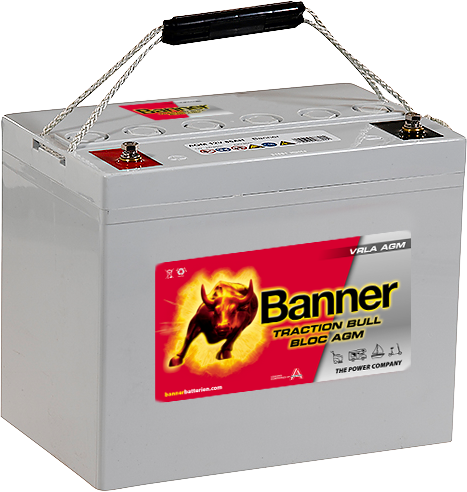HOBBY AND LEISURE BATTERIES - POWER YOUR ADVENTURES
WHAT YOU NEED TO KNOW
Power to take with you. Choosing the right battery for camping/caravans/motorhomes is not always easy.
But the following factors are crucial: capacity requirement, cycle life and optimal mounting space.
The Energy Bull is a special wet-cell battery for slow discharge in the hobby and leisure segment. The Energy Bull is designed to be robust and the ideal energy storage solution for camping/caravanning, use as a motor mover battery (manoeuvring system for caravans), for boat trips and for many other applications right down to indicator systems and traction batteries for electric motors.
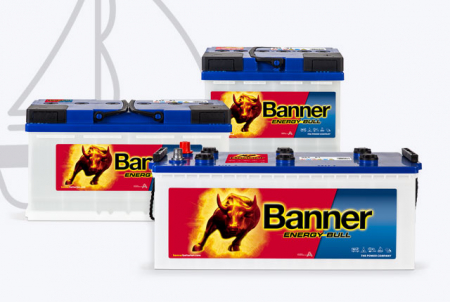
Charging
Make sure that the supply cable is dimensioned appropriately (to minimise voltage losses). The charging voltage for Energy Bull batteries should be 14.2 - 14.4V. We recommend a charging current of at least one-tenth of the battery capacity (e.g. 100Ah: 10 = 10A charging current). All in all, the Energy Bull is a good cyclic-use battery that is very forgiving (as compared to gel or AGM batteries). The main difference between Energy Bull batteries and AGM or gel batteries is in their maintenance. The electrolyte level must be inspected regularly while using the Energy Bull battery. During periods of intensive use (such as camping), this inspection should be carried out monthly; otherwise, quarterly or biannual maintenance is sufficient. Gel or AGM batteries are maintenance-free. The price and resistance to higher temperatures and higher charging voltages speak in favour of the Energy Bull. Make sure that the charger is compatible with the battery technology and has a suitable characteristic curve.
Caution: A highly explosive oxygen-hydrogen mix can form during charging. Fire, naked flames and smoking are prohibited.
Solar
Make sure that the solar cell has an appropriate and ““good”” regulator. Ideally, this should feature PWM (pulse-width modulation), temperature compensation and freely selectable parameters (charging voltage, etc.).
Discharging
Inverters require a certain amount of discharge current from the battery. Energy Bull and gel batteries are generally not suitable for high-current discharges (>40-fold nominal voltage*, for >1 min.). If you require higher discharge currents, we recommend using an AGM battery (Traction Bull Bloc AGM or Running Bull AGM).
Series or parallel circuit
Please note:
- Both batteries must have the same type designation.
- Both batteries must be around the same age.
- Both batteries must have the same state of charge.
- The connecting cables must be sufficiently dimensioned
and be kept as short as possible. - Always change both batteries.
If the above-mentioned recommendations are not observed, a series circuit will result in a corresponding division of the voltage due to the different internal resistances of the individual batteries and thus in an asymmetrical (= unbalanced) load during the charging and discharging phase. A charging equaliser is used to maintain an equal level of charge for two batteries connected in series. With batteries connected in parallel, high compensation currents sometimes flow between the batteries. If possible, we recommend that you use just one higher-capacity battery.
Series connections (= series circuit), add together the voltages of the individual batteries. Two 12V batteries must be connected in series to create a 24V electrical system.
Parallel connections add together the individual capacities and cold start currents of the individual batteries.
Degassing
Banner recommends: For safety reasons, always use a degassing tube when installing the battery in the interior/passenger compartment, as this will discharge any gases caused by overloading or high ambient temperatures to the outside. When selecting a battery, choose a type that has a central degassing connection. This can be seen from the GA (gas outlet) note in the technical details = battery with central degassing.
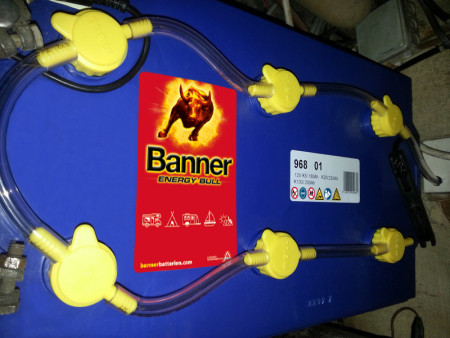
Banner tip: Reisskamina central degassing system
This system for easy and safe retrofitting was developed specifically for long-term discharge batteries in the hobby and leisure segment, without an integrated central degassing unit in the battery cover.
Ideal for all Energy Bull flat cover batteries with 27 mm screw connections (battery box A – type 960 51, box B – type 963 51 and box C – type 968 01).
Can also be used for Buffalo Bill utility vehicle batteries with flat cover and 27 mm screw connections (battery box A – type 620 34/640 35, box B – type 680 32 and box C – type 725 11).
AGM and gel batteries do not emit any gas under normal operating conditions (unless there is a fault with the charger or the battery).
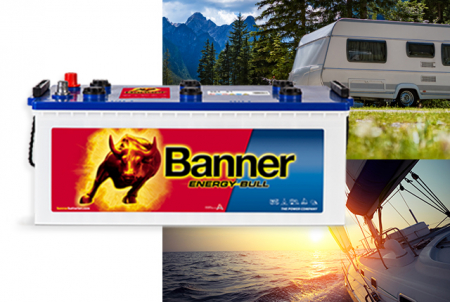
Capacity
Ideally, batteries should only be operated with low discharge depths (max. 50% discharge depth). A lead-acid battery has a certain capacity (= number of recharges of nominal capacity). The flatter the cycle, the higher the number of possible repetitions. In terms of cycle capability, with sufficient care, the Traction Bull Bloc AGM battery has around double the lifetime of the Energy Bull.
Cycles
Approximate number of cycles at max. 50% discharge depth:
- Energy Bull: up to 270 cycles. Use: Almost always used with power connections and minimal off-grid operation of standard consumers, e.g. lighting (low battery energy requirement). NCC National Caravan Council - Class C.
Despite a higher purchase price, a battery with higher cycle stability can pay off over its lifetime, but this always depends on the particular application. In addition, buyers can save on costs for often complex installation and removal including new purchase and transportation.
Calculating the capacity requirement
How to calculate the right capacity for your on-board power system battery:
Below, you can see an example of how to determine the power requirement for your use.
Ah Required battery: Energy Bull 96801 K5 = 180 Ah
If the average power-on time is approx. 5 hours, the K5 is used. If it’s approx. 20 hours, the K20 is used and if approx. 100 hours, the K100. With conventional batteries, the safety factor (to prevent deep discharges) should normally be 1.7 (1.3 with recombination batteries, i.e. AGM and gel).
| Device |
P performance in W |
U voltage in V |
Current I - P/U in A |
Activation tim in h |
Capacity K = Ixt in Ah |
| Mini-fridge | 100 | 12 | 8,3 | 8 | 66 |
| Mini-TV | 80 | 6,7 | 2 | 13 | |
| Lighting | 40 | 3,3 | 4 | 13 | |
| Kettle | 200 | 16,7 | 0,15 | 3 | |
| Hotplates | 500 | 41,7 | 0,2 | 8 | |
| Total | 103 | ||||
| Required battery capacity (=total multiplied by a safety factor of 1.7) | 175 | ||||
The difference between power supply batteries and starter batteries
Power supply batteries
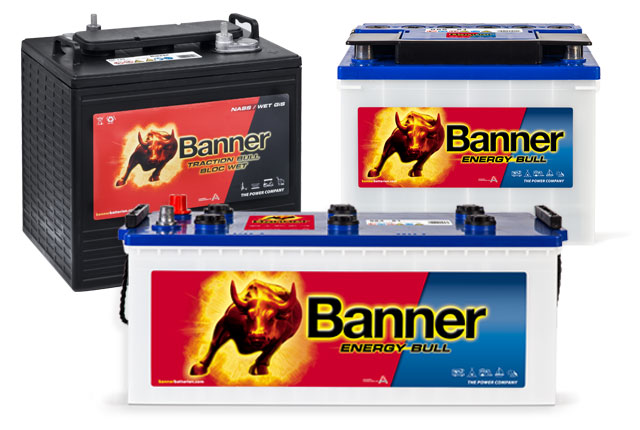
A long-term discharge battery in the hobby and leisure segment is needed to provide a much lower amount of current to the on-board power supply over a longer period of time and to a variety of electrical/electronic consumers. It can also be discharged and recharged many times.
The technology and components are therefore very different from those of a starter battery, meaning that using a starter battery in a cyclical application could lead to premature battery wear right down to total battery failure during the first months of operation.
Starter batteries
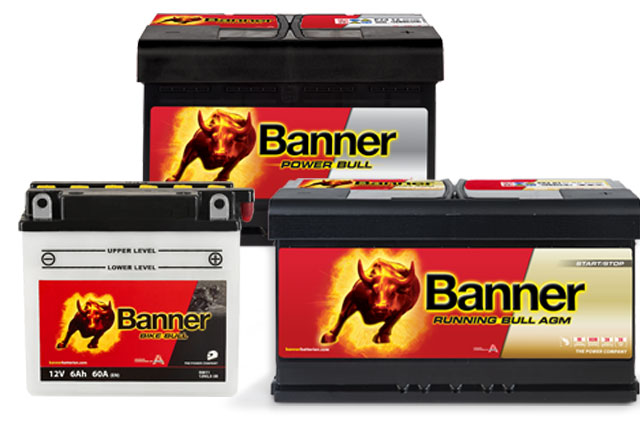
As the name suggests, a conventional starter battery is basically designed to provide a high, short energy boost for starting a motor vehicle. Once the engine is running, the vehicle’s charging system makes sure that the energy taken from the battery is replaced.
It’s best to use a starter battery to start the engine. Banner offers original equipment batteries with the Running Bull EFB/PROfessional and the Power Bull/PROfessional (OE quality for replacement needs).
Good to know. A motorhome almost always uses a combination of starter battery for starting the engine and long-term discharge batteries for supplying all additional electrical/electronic consumers (e.g. lights, fridge, entertainment system, etc.).
Banner tip: For a long on-board battery service life
An Energy Bull on-board battery should only be discharged to a maximum of 50% of its charge level. In general, the deeper the discharge, the shorter the expected service life. Be sure to recharge your battery immediately and sufficiently after each discharge.
The Energy Bull is the ideal battery for caravan use with power connections at the camping site and with minimal off-grid operation of standard consumers, e.g. lighting. It is also a good choice for motorhomes that travel longer distances on a daily basis, where the alternator charges the battery sufficiently and fully. In precisely these applications, the battery is not deeply discharged, and is immediately and sufficiently recharged, meaning that the additional costs of purchasing a deep-cycle battery cannot be justified.
That’s why it’s always best to use the correct specification and technology when choosing a battery to suit your specific needs.
Rule of thumb
Energy Bull: Almost always used with power connections and with minimal off-grid operation of standard consumers, e.g. lighting (low battery power requirement).
Traction Bull Bloc AGM (Deep-Cycle): More often used with power connections, with moderate off-grid operation of additional consumers, e.g. lights, satellite system with television, manoeuvring system/motor mover with motor drive (moderate to high energy requirement in terms of battery design).
Traction Bull Bloc Gel (Deep-Cycle): Mostly used without power connections, with maximum additional equipment (highest energy requirement for batteries).
Our upgrade recommendation
for higher power requirements, higher cycle stability or 100% leak protection is the
You might also be interested in the following


